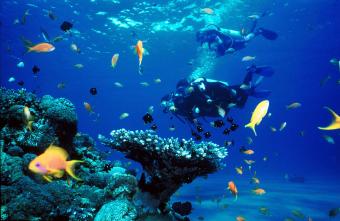
By Simon Cross
Posted: 6th August 2013 14:10
With the Caribbean, the Pacific, and of course, the Gulf of Mexico all positioned off Mexico’s extensive coastline, the country has become something of a diving haven. The warm, tropical waters provide great conditions for those wishing to explore life below the surface and high levels of biodiversity ensure an array of wonderful creatures to see in their natural habitat. With Mexican ports playing a key role in naval activity within the region throughout the years, there are a host of unique sites to explore, with Mexico’s crystal-blue waters making them all the more easier to view.
Mesoamerican Barrier Reef
Just off the coast of Cancun lies the largest barrier reef in the Northern Hemisphere, the Mesoamerican Barrier Reef. Stretching over 1000 kilometres across the Caribbean, the reef is home to many exotic and colourful creatures, including several species of endangered sea turtles. These graceful and rare creatures thrive within the reef due to the nesting site located nearby. Divers swimming within the area will get an extraordinary opportunity to see these elegant creatures in their natural environment.
However, the northern regions of the reef, (which is the section off the coast of Cancun) are the home to the largest sea mammal in the world, the Whale Shark. These majestic animals often group up just off Isla Contoy to mate, as well as eat the plankton present in the region. These docile and playful creatures often display a playful attitude towards humans, and these harmless creatures often show gentle affection towards divers.
The significance of the Reef for many endangered species, as well as its outstanding beauty led it to be declared as a UNESCO World Heritage Site in 1996, and divers will agree that this title is richly deserved after their time there.
Yucatan Cave Diving
Millions of years ago, the porous nature of Yucatan’s limestone ground led to the creation of a vast series of flooded cave networks throughout the coastal region of the province. These caves provide divers with a rich array of deep diving locations within a picturesque location.
Sistema Sac Actum is the most significant cave within the region, for it was here that a giant Mastodon fossil was discovered in 2008, giving a greater level of understanding to the natural make-up of Prehistoric Mexico. Divers who do not find themselves intrigued by the possibility of making such a find themselves, will be astounded by the amounts of areas to explore within the longest surveyed underwater cave system in the world.
Another cave dive within Mexico which is famous within the diving community is the Zacaton sinkhole. Due to its extreme depth, the site has fascinated many divers, and is the location at which NASA tested some of its exploration technology, seeing the bottom of the cave for the first time in 2007. No human has ever successfully reached the bottom of Zacaton, and it remains a stern test for any diver.
Cancun Underwater Museum
In 2004, a groundbreaking and innovative project by the British artist Jason deCaires Taylor led to the creation of one of the most fascinating dive sites in the world, the Cancun Underwater Museum. Over 400 sculptures have been placed in the sea-bed off the coast, and with the maximum depth of the museum being just 20 feet; the site is an ideal place for inexperienced divers as well as seasoned veterans, and with the use of materials designed to promote the growth of natural coral life, the Museum’s serene beauty will only continue to grow as the years pass.
An average sea temperature of 26 degrees, as well as pristine waters ensure that the site can be easily viewed and fully explored, and the “Silent Evolution” centrepiece gives a snapshot of the development of Mexico’s indigenous people. As coral life takes over the site, it will experience its own, personal silent evolution as wondrous flora and fauna flock to the site, and other artists make their own contributions to the museum.
Great White Shark Diving
One of nature’s most prestigious predators has made their home within Mexican waters. The Great White frequently patrols the waters surrounding the Guadalupe Islands, drawn to the area by the large amount of seals, and as a result, this is one of the best shark-spotting sites in the world.
The clear waters and the natural abundance of this magnificent animal make them incredibly easy to spot, ensuring that divers won’t leave disappointed. Sharks in this region usually peak in numbers around July, when the warm summer climate is at its best, this will guarantee an exhilarating and thoroughly enjoyable experience. The behaviour of the Great White in this region is more natural than at other Shark sites, as the Sharks do not need to be forcibly attracted to a specific spot. This is partly due to the high population levels, but the high levels of visibility underneath the surface also help divers to make the most of this incredible opportunity.



Comments